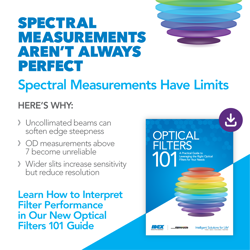Limitations Of Spectral Measurements

Spectral measurements of optical filters using standard spectrometers face significant limitations, particularly when assessing filters with steep spectral edges and deep optical density (OD) blocking. Traditional spectrometers use uncollimated beams, typically with a cone half angle (CHA) of 3–5°, which results in spectral averaging across angles. This softens edge transitions and reduces measurement precision. Additionally, limited sensitivity in standard systems makes it difficult to reliably measure OD values above 7, often leading to inaccurate representations of filter performance.
To compensate for low sensitivity, users often widen the spectrometer slits, which increases light throughput but compromises spectral resolution, smoothing out steep features and introducing artifacts. Narrowing the slits improves resolution but reduces sensitivity, creating a difficult trade-off for accurate measurements.
IDEX Health & Science has solved these challenges by developing proprietary spectral measurement systems. The Peregrine SMS minimizes angular integration errors with a CHA of less than 0.3°, enabling precise characterization of sharp transitions and steep filter edges. It has been a cornerstone in the development of Semrock’s advanced multi-band and steep-edge filters.
Building on this, the KolaDeep SMS offers best-in-class OD sensitivity without sacrificing spectral resolution. It can accurately measure OD >8 from 275–800 nm and OD >7 from 800–1100 nm, while capturing detailed edge slopes and full transmission characteristics.
These innovations allow IDEX Health & Science to deliver filters with unmatched spectral precision and performance, ensuring that customers receive reliable, application-ready optical components tested with the industry's most advanced tools.
Get unlimited access to:
Enter your credentials below to log in. Not yet a member of Photonics Online? Subscribe today.
